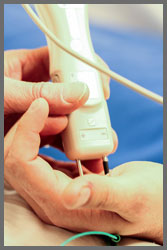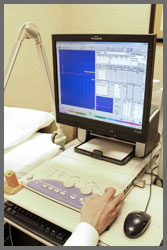Electromyography & Nerve Studies
Test Overview
 Nerves control the muscles in the body using electrical impulse. Whenever a muscle contracts (tenses up), in response to a signal from the brain it also produces an electrical discharge of its own. Electromyography (EMG) measures the electrical discharges made by the muscles. Nerve conduction studies (nerve conduction velocity) measures how well individual nerves can transmit electrical signals. Measuring the electrical activity in muscles and nerves can help detect presence, location, and extent of diseases that can damage muscles and nerves. The actual site of nerve damage can often be located. EMG and nerve conduction studies are often done together to provide more complete information.
Nerves control the muscles in the body using electrical impulse. Whenever a muscle contracts (tenses up), in response to a signal from the brain it also produces an electrical discharge of its own. Electromyography (EMG) measures the electrical discharges made by the muscles. Nerve conduction studies (nerve conduction velocity) measures how well individual nerves can transmit electrical signals. Measuring the electrical activity in muscles and nerves can help detect presence, location, and extent of diseases that can damage muscles and nerves. The actual site of nerve damage can often be located. EMG and nerve conduction studies are often done together to provide more complete information.
Why It Is Done
Electromyography is done to:
- Help diagnose problems that damage muscles tissue, nerves, or the junctions between nerve and muscle.
 Nerve conduction studies are done to:
Nerve conduction studies are done to:
- Detect and evaluate damage to the peripheral nervous system (which includes all the nerves that lead away from the brain and spinal cord and the smaller nerves that branch out from those nerves.)
- Identify the cause of abnormal sensations such as numbness, tingling or pain.
How to Prepare
Tell your doctor if you:
- Are taking any medications. Certain medications can interfere with EMG results.
- Have had bleeding problems or are taking medications that thin the blood.
- Are wearing a pacemaker or defibrillator.
You do not need to restrict your foods or fluids.
Lotions interfere with the study. Please do not wear lotion on the day of your test.
Please wear a loose fitting shirt if you are having an upper EMG on your upper extremities.
